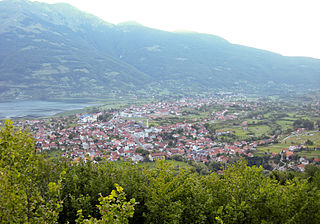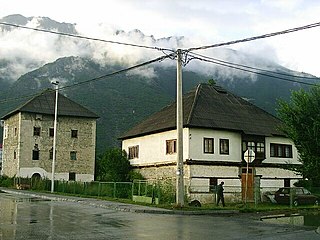
Plav is a town in Montenegro in the northern region. It has a population of 3,717. Plav is the centre of Plav Municipality.

Gusinje is a small town in Montenegro in the northern region. According to the 2011 census, the town has a population of 1,673 and is the administrative center of Gusinje Municipality.

The Accursed Mountains, also known as the Albanian Alps, is a mountain range in coastal Southeast Europe adjacent to the Adriatic Sea. It is the southernmost subrange of the 1,000-kilometre-long (621 mi) Dinaric Alps range (Dinarides), extending from northern Albania to southern Kosovo and northeastern Montenegro. Maja Jezercë, standing at 2,694 m (8,839 ft), is the highest point of the Accursed Mountains and of all Dinaric Alps, and the fifth highest peak in Albania. The range includes the mountain Zla Kolata, which, at 2,534 m (8,314 ft), is the tallest mountain in Montenegro. The range also includes the mountain Gjeravica, which, at 2,656 m (8,714 ft), is the second tallest mountain in Kosovo. One of the southernmost glacial masses in Europe was discovered in the Albanian part of the range in 2009.

Hekurudha Shqiptare or HSH(Albanian Railways) is the state-owned operator of the Albanian railway system and became a private company in 2005. The system's main passenger terminal was Durrës railway station in the port city of Durrës.

Bajzë is a small town in the former Kastrat Municipality, Shkodër County, northern Albania. At the 2015 local government reform it became part of the municipality Malësi e Madhe. It has a population of 2,346.

Hoti is a historical Albanian tribe (fis) and sub-region of Malësia, a divided area located in northern Albania and southern Montenegro. Its geography is mostly mountainous, but some of its villages are on flat terrain near the banks of Lake of Shkodër.

Railways in Albania are administered by the national railway company Hekurudha Shqiptare (HSH). It operates a standard-gauge railway gauge rail system in Albania. All trains are, currently, hauled by Czechoslovak-built ČKD diesel-electric locomotives.

The Battle of Deçiq was a battle between Albanian tribesmen and Ottoman forces during the Malësori uprising of 1911. It was a turning point for Albania's secession from the Ottoman Empire. Dedë Gjo Luli, the organiser of the Albanian tribal forces, raised the Albanian flag for the first time since 1479 on the mountain of Deçiq after the Albanians had achieved victory over the Ottoman Turks.
Border crossings in the Republic of Albania are defined as boundary checkpoints that serve to control the flow of people and goods from neighbouring countries to and from Albania. These checkpoints are administered by the border police authorities that record the entry and exit of each person and vehicle followed by the customs authorities that record the entry and exit of goods and cash. Albania currently has 22 operational land border crossings and shares borders with Montenegro, Kosovo, North Macedonia, and Greece. This article outlines a complete list of Albania's international border crossings, including land, sea and air entry points.

Vermosh is the northernmost village of Albania, located in the former Kelmend municipality. At the 2015 local government reform it became part of the municipality Malësi e Madhe. The village lies in a valley of the Albanian Alps, along a river with the same name.

The Bajzë Rail Station is a railway station located in Bajzë, Albania. It is operated by Hekurudha Shqiptare (Albanian Railways) and part of Montenegrin-Albanian cross-border freight line between Podgorica, capital of Montengero, and Shkodër, Albania. Two freight trains pass daily through the station, hauling over 10,000 tonnes of commodities monthly. Long term plans exist to establish and operate international passenger trains between Albania and Montenegro via Bajzë. The vast majority of Albanian entrepreneurs import their goods through the railway line from all over Europe, as transport through train is about 50% cheaper than road transport. Cleaning of toxic chemicals, which had been dumped during 1991-1992, finished in 2009.
The Podgorica–Shkodër railway is a railway connecting Albania and Montenegro, used for freight-purposes only. It is Albania's only international rail link. Although initially built between 1984 and 1985, it fell into disuse in 1991 and later fully reopened in 2003.

The national road SH1 is a national highway in Albania. It has a length of 125 kilometres (78 mi) across the counties of Durrës, Lezhë, Shkodër and Tirana.

Krasniqi is a historical Albanian tribe and region in the Accursed Mountains in northeastern Albania, bordering Kosovo. The region lies within the Tropoje District and is part of a wider area between Albania and Kosovo that is historically known as Gjakova highlands. Krasniqi stretches from the Valbona river in the north to Lake Fierza in the south and includes the town Bajram Curri. Members of the Krasniqi tribe are also found in Kosovo and Northern Macedonia.

The Highways in Albania are the central state and main transport network in Albania. The motorways and expressways are both part of the national road network. The motorways are primary roads with a speed limit of 110 kilometres per hour (68 mph). They have white on green road signs such as in Italy and other countries nearby. The expressways are the secondary roads, also dual carriageways, but without an emergency lane. They have a speed limit of 90 kilometres per hour (56 mph). They have white-on-blue road signs.

Shkodër railway station is the main railway station in Shkodër County, Albania. It is the northernmost passenger station in Albania.

The Border and Migration Police is a law enforcement branch of the Albanian State Police. It is tasked to oversee and control the transiting of goods and persons across the country's territory. The Border and Migration Police carries out enforcement measures to prevent the illegal border crossings of foreign nationals and nationals engaged in the illegal trafficking of goods. It cooperates with other state police branches in effort to facilitate an efficient management of the borders that are safe and secure.

Shkodër is the fifth-most-populous city of the Republic of Albania and the seat of Shkodër County and Shkodër Municipality. Shkodra has been continuously inhabited since the Early Bronze Age, and it has roughly 2,200 years of recorded history. The city sprawls across the Plain of Mbishkodra between the southern part of Lake Skadar and the foothills of the Albanian Alps on the banks of Buna, Drin and Kir. Due to its proximity to the Adriatic Sea, Shkodër is affected by a seasonal Mediterranean climate with continental influences.
Nora of Hoti or Lula Hoti was an Albanian freedom fighter and local heroine who fought alongside Ded Gjon Luli against Serb and Ottoman armies. Afterwards, during the Zog regime and Communist take over, she was treated badly and interrogated in Shkoder, and his fighters against Ottoman and Serb armies in 1910–1912. Nora Luli was married to Gjelosh Luli, the son of Ded Gjon Luli. Nora was given the "Hero of the People" award.
















